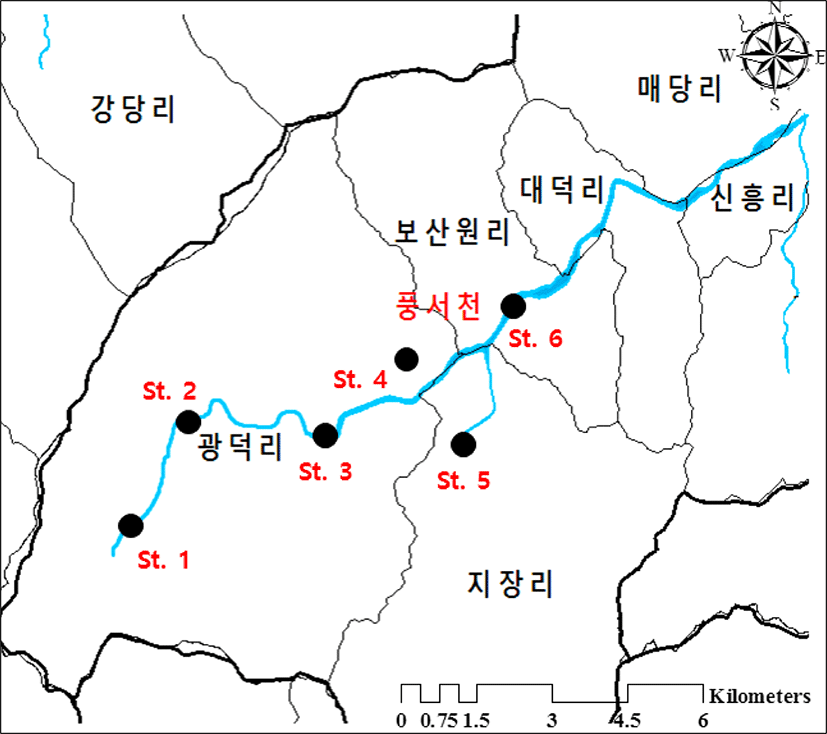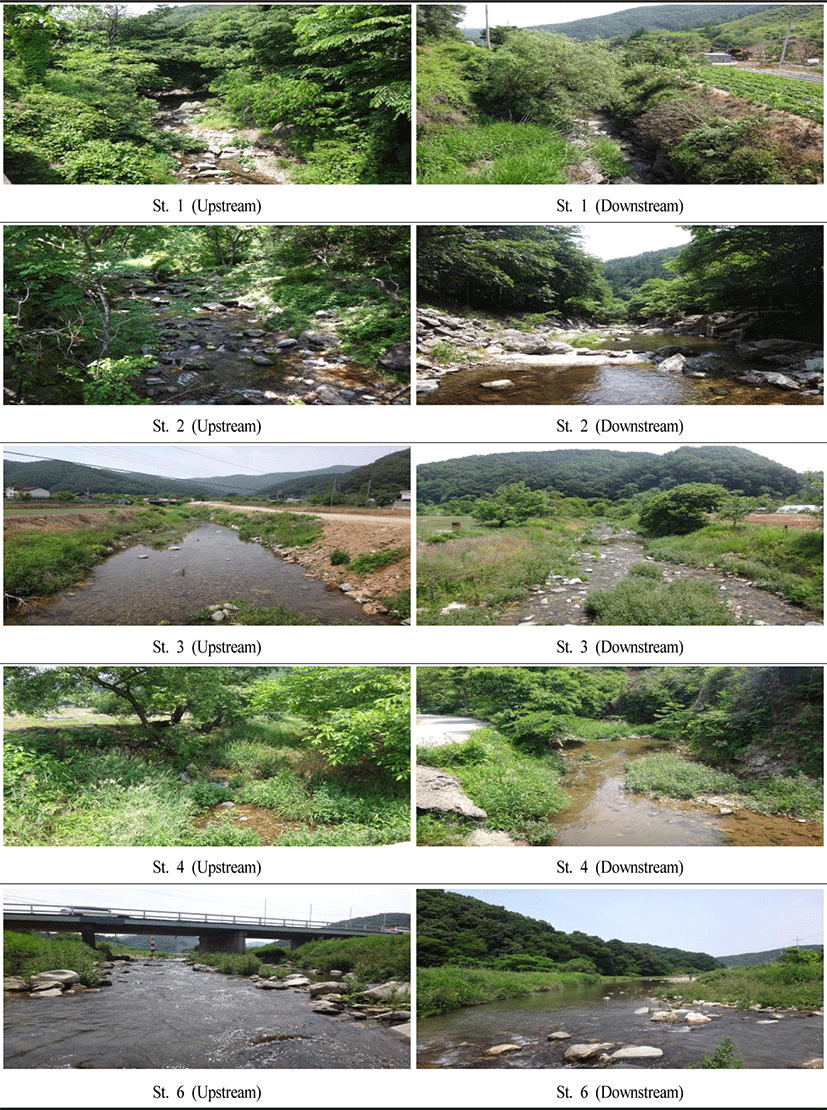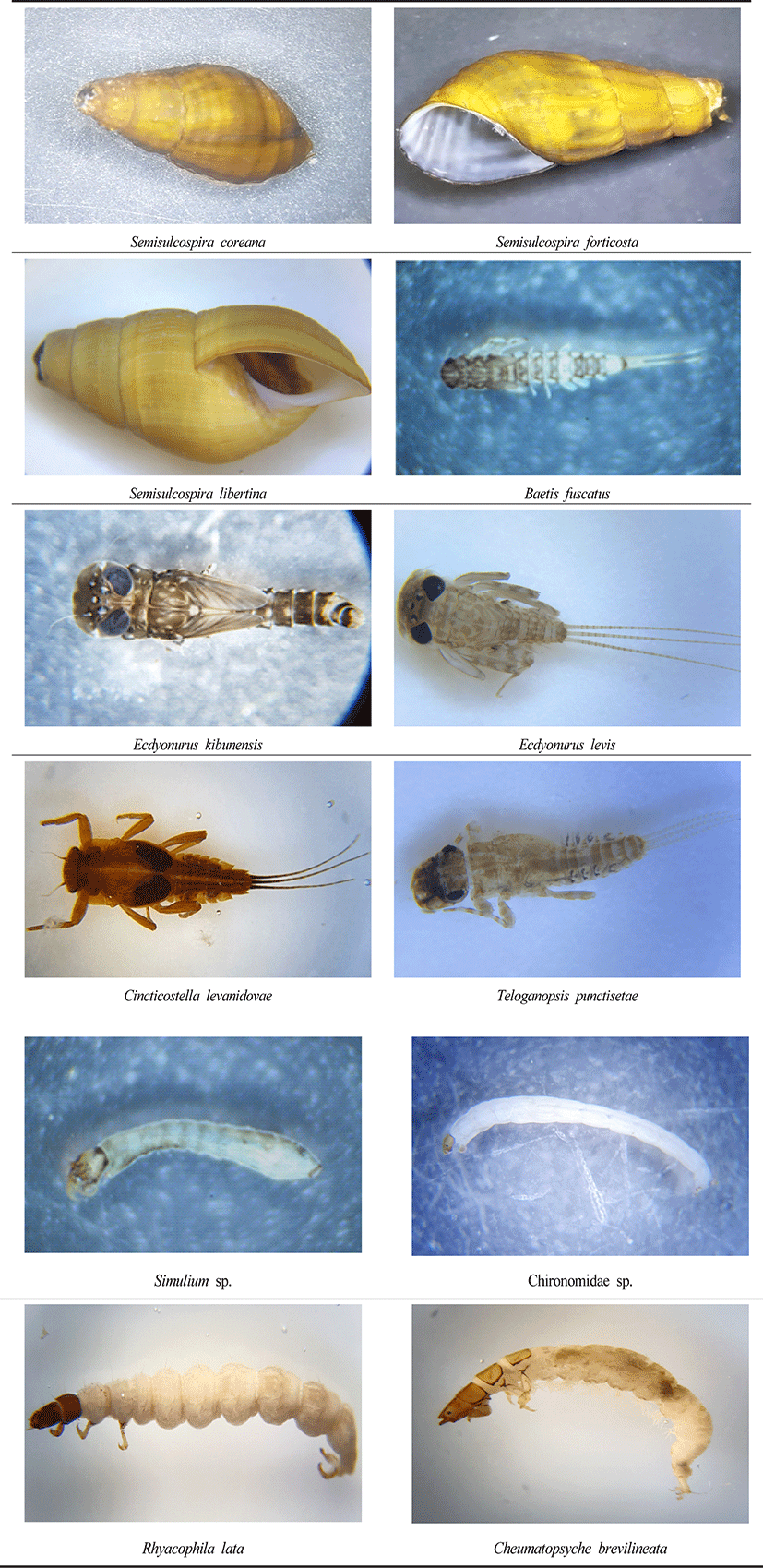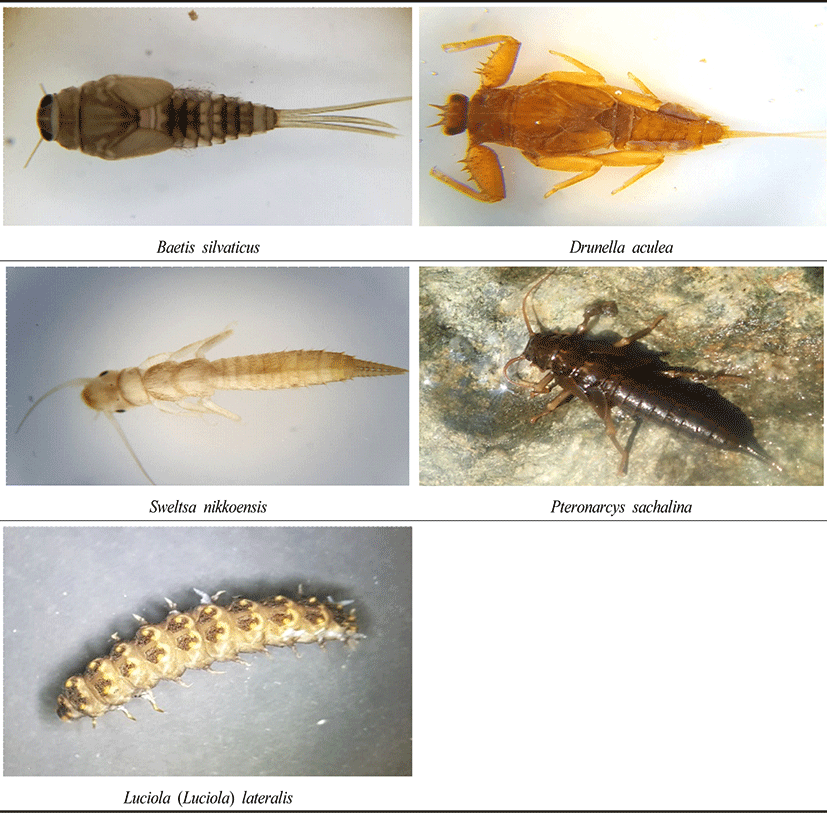서 론
광덕산(699.3 m)은 충청남도 아산시 송악면과 천안시 동남구 광덕면의 경계에 위치해 있다. 광덕산 내 주요 하천으로서 본 조사의 대상지인 풍서천은 광덕산에서 발원하여 북동측으로 흘러 곡교천에 합류한다. 광덕산은 도심 속의 일반적인 산들과 비교하여 식생이 잘 보전되어 있고 식물구계학적으로 보전 및 연구가치가 큰 것으로 평가되고 있다(전 등, 2021). 또한 애반딧불이, 운문산반딧불이, 늦반딧불이를 포함한 다양한 생물들이 서식하여 동ㆍ식물상이 우수한 생태계변화관찰지역(금강유역환경청, 2009)으로 선정되었다. 곡교천 상류의 다른 지역과 더불어 풍서천 일대는 1935년부터 남관 취수장의 수원지로 이용되어 왔으며, 1985년에는 풍세면 남관리(남관 취수장) 및 인근 지역이 상수원 보호구역으로 선정되었다. 천안시에서는 다슬기를 섭식하는 반딧불이의 개체수 유지를 위해 풍서천에서 다슬기 방류행사를 진행하기도 하였다(천안시, 2006). 또한 천안시에서는 2011년부터 2016년까지 ‘풍서천 고향의 강 조성사업’(천안시 공고, 제2012-227호)을 진행하였으며, 2단계 사업으로 2017년부터 2022년까지 ‘풍서천 하천 정비사업’(천안시 공고, 제2019-2146호)을 진행 중이다.
광덕산이 비교적 도심에 가까이 위치해 있고 자연환경이 우수한 만큼 많은 휴양객들이 방문하고 있다. 여러 문화재를 보존하고 있는 광덕사와 등산로가 잘 정비되어 있는 강당골, 잣나무 군락지, 장군바위 등을 중심으로 다양한 펜션 및 야영장이 들어 서 있다. 높은 생물다양성을 지니고 있는 광덕산과 풍서천의 가치를 평가함은 물론 여러 교란요인에 의한 변화를 파악하여 보전 및 복원 방안을 마련하기 위해서는 주기적인 모니터링이 필수적이다.
풍서천의 저서성 대형무척추동물은 자연생태계 지역정밀조사(천안 광덕산; 환경처, 1994), 제3차 전국자연환경조사(광덕; 환경부, 2007), 제4차 전국자연환경조사(풍서천 유역; 환경부, 2014), 하천 수생태계 현황 조사 및 건강성 평가(풍서천; 환경부·국립환경과학원, 2018, 2021)에서 일부 조사된 바 있다. 그러나 해당 조사의 대부분은 풍서천의 하류 지점에서 수행된 것으로서 상류 지점의 조사 자료는 부족한 상황이다. 따라서 본 연구의 목적은 풍서천 상류와 일부 지류의 저서성 대형무척추동물 군집을 조사하고 그 다양성과 건강성을 평가하는 것이다. 본 연구의 결과는 향후 광덕산 담수생태계의 변화를 파악하고 보전방안을 수립하는데 기초 자료로 활용될 것으로 기대된다.
조사 방법
풍서천 상류의 본류 4개 지점과 지류 2개 지점을 포함하여 총 6개 지점을 조사하였다(Fig. 1). 각 지점에 대한 정보는 Table 1과 같다.

각 지점별로 여울, 흐름, 소, 수변식생으로 조사 정점을 구분하고, D-frame net (30×30 cm, mesh 0.5 mm)을 사용하여 정점별 1회씩 총 4개의 방형구 조사를 통해 저서성 대형무척추동물을 정량 채집하였다. 채집된 시료는 채집병에 넣어 현장에서 Ethyl alcohol 95%에 고정하였고, 실험실로 운반하여 생물시료를 골라낸 후 Ethyl alcohol 80%에 보존하였다.
윤(1988, 1995), 원 등(2005), 배(2010), 공 등(2013), 권 등(2013), 김 등(2013)의 문헌을 이용하여 수서곤충류를 동정하였다. Wiederholm(1983)의 문헌을 이용하여 깔따구류의 외부형태, 머리모양, 특히 Abdominal tubules의 유무, Antennal segment의 길이, 강모의 형태 등의 특징을 고려하여 과(Family) 수준에서 동정하였다. 학명 및 국명은 기본적으로 하천 수생태계 현황조사 및 건강성 평가(환경부·국립환경과학원, 2021)의 분류체계를 따랐다.
정량채집 자료를 이용하여 우점종, McNaughton(1967)의 우점도지수(Dominance index; DI), Margalef(1958)의 풍부도지수(Richness index; R), Shannon-Weaver(1949)의 다양도지수(Diversity index; H'), Pielou(1975)의 균등도지수(Evenness index; J)를 산출하였다.
McNaughton(1967)에 따라 전체 개체수에 대한 제 1우점종과 제 2우점종의 개체수 비로 산출하였다.
N : 총 개체수
N1, N2 : 제 1, 2 우점종의 개체수
Margalef의 정보이론에 의하여 유도된 Shannon-Weaver function (H') (Shannon & Weaver, 1949)을 Lloyd & Gheraldi(1964)가 변형한 공식에 따라 산출하였다.
Ni : i번째 종의 개체수
Pi : i번째 종의 개체수 비율
Margalef(1958)에 따라 군집의 총 개체수 및 종수를 이용하여 산출하였다.
S : 총 종수
N : 총 개체수
Pielou(1975)에 따라 이론적인 최대다양도에 대한 실제다양도의 상대비로 산출하였다.
H'= Shannon-Weaver 지수
S : 총 종수
(1) 저서성 대형무척추동물 총생태점수(Total Ecological Score of Benthic Macroinvertebrate Community, TESB)
Kong et al.(2018)에 따라 산출하였다(Table 2).
s : 총 종수
Qi : i 종에 대한 환경질 점수 (=1, 2, 3, 4, 5)
(2) 저서성 대형무척추동물 평균생태점수(Average Ecological Score of Benthic Macroinvertebrate Community, AESB)
Kong et al.(2018)에 따라 출현 지표생물종의 환경질 점수의 평균을 구하였다(Table 2).
s : 총 종수
Qi : i 종에 대한 환경질 점수 (=1, 2, 3, 4, 5)
(3) 복합 저서성 대형무척추동물 생태점수(Revised Ecological Score of Benthic Macroinvertebrate Community)
Kong et al.(2018)에 따라 TESB와 AESB를 복합적으로 적용하여 평가하였다.
결과 및 고찰
풍서천의 조사지점 중 최상류에 해당하는 갈재교지점(St.1)의 양안에는 각각 도로와 농경지가 있었다(Fig. 2). 1차 조사 시 농경지 인근에서 공사가 진행 중이었다. St. 1은 전체 조사지점 중 수온이 가장 낮았고, 하상은 주로 조립질이었다(Table 3).
태화교지점(St. 2)의 좌안에는 도로가 위치하고, 우안에는 펜션이 들어 서 있어 휴양객들이 하천에 빈번히 출입할 것으로 예상되었다. St. 2는 수심이 비교적 얕고, 수온은 낮았다.
광덕교지점(St. 3)의 양안에는 농경지가 조성되어 있고 캠핑장과 휴게소 및 편의시설이 인근에 밀집해 있었다. St. 3은 비교적 수심이 얕고 유속이 빨랐다.
광덕산 동쪽에 위치한 풍서천지류지점(St. 4)의 좌안에는 도로가, 우안에는 민가들이 있었다. 수심이 얕고 수온은 상대적으로 높았으며 하상은 주로 세립질이었다.
지류인 지장천(St. 5) 역시 좌안에는 도로가, 우안에는 민가들이 있었다. 조사지점 중 수온이 가장 높았고 수심은 대체로 깊었으며, 하상은 대체로 조립질이었다.
조사지점 중 최하류에 해당하는 보산원교지점(St. 6)의 좌안에는 상가와 음식점이 있었다. 다른 지점과 비교하여 수피도가 옅고 수심이 가장 깊었다. 하상은 주로 조립질이었다. 조사지점 중 접근성이 가장 용이한 곳이어서 조사 시에 많은 휴양객들이 여가활동을 하고 있었다.
풍서천에서 본 조사의 정량 채집을 통하여 출현한 저서성 대형무척추동물은 총 4문, 6강, 16목, 52과, 91종이었다. 곤충류는 하루살이목 24종, 잠자리목 7종, 강도래목 6종, 뱀잠자리목 1종, 딱정벌레목 7종, 파리목 12종, 날도래목 21종으로 총 78종이 출현하였으며, 비곤충류는 편형동물문 1종, 연체동물문 7종, 환형동물문 3종, 연갑강 1종, 톡토기강 1종으로 총 13종이 출현하였다(Appendix 1, Appendix 2). 모든 조사지점에서 다슬기(Semisulcospira libertina), 실지렁이(Limnodrilus gotoi), 개똥하루살이(Baetis fuscatus), 두점하루살이(Ecdyonurus kibunensis), 네점하루살이(Ecdyonurus levis), 부채하루살이(Epeorus pellucidus), 무늬하루살이(Ephemera strigata), 민하루살이(Cincticostella levanidovae), 등줄하루살이(Teloganopsis punctisetae), 먹파리류(Simulium sp.), 깔다구류(Chironomidae sp.), 올챙이물날도래(Rhyacophila lata), 꼬마줄날도래(Cheumatopsyche brevilineata), 동양줄날도래(Hydropsyche orientalis)가 출현하였다.
광덕산 조사지점 전체에서 깔따구류 sp.를 제외한 우점종과 아우점종은 두점하루살이(Ecdyonurus kibunensis, 17.0%)와 개똥하루살이(Baetis fuscatus, 11.2%)로 나타났다. 지점별로 1차 조사에서 두점하루살이(St. 1, St. 4, St. 5), 깔따구류 sp.(St. 2), 먹파리류 sp.(St. 3), 개똥하루살이(St. 6) 등이 각각 우점종으로 출현하였다. 2차 조사에서는 깔다구류 sp.(St. 1, St. 4), 민하루살이(St. 2, St. 5, St. 6), 개똥하루살이(St. 3)가 우점종으로 출현하였다(Table 4).
본 조사의 최상류 지점인 갈재교 지점의 고도는 267m로 고지대라고 할 수 없다. 그럼에도 감초하루살이(Baetis silvaticus), 뿔하루살이(Drunella aculea), 녹색강도래(Sweltsa nikkoensis), 큰그물강도래(Pteronarcys sachalina) 등 청정수역의 냉수성 종들이 일부 출현하였는데 이는 조사지역이 전반적으로 인위적인 교란이 적고 수피도가 높은데 따른 것으로 보인다(Appendix 3).
1994년 자연생태계 지역정밀조사(환경처, 1994)에서 광덕산 및 풍서천 상류에서 애반딧불이 200여 개체의 집단 서식이 처음으로 밝혀져 1997년 풍서천 유역을 천연기념물 보호구역으로 지정하려는 시도가 있었다. 지난 2017년에는 천안시지속가능발전협의회에서 광덕사 일원에서 애반딧불이, 운문산반딧불이, 늦반딧불이를 확인한 바 있다. 본 조사에서는 보산원교지점(St. 6)에서 애반딧불이 유충 1개체가 출현하였다. 그간에 풍서천 반딧불이는 주로 상류지역에서 기록되어 왔으므로 본 조사에서 출현한 유충이 하류지역에 서식하는 것인지 상류로부터 유하(drift)된 것인지를 포함하여 그 서식 실태를 세부적으로 파악하기 위해서는 이 종의 생활사에 맞추어 다양한 시기에 조사가 이루어져야 할 것이다.
조사지점 중 St. 1은 균등도와 저서성 대형무척추동물 평균 생태점수(AESB)가 가장 높았으며, 종풍부도와 저서성 대형무척추동물 총 생태점수(TESB)가 가장 낮았다(Table 5, 6). St. 2는 종다양도와 균등도가 가장 낮았다. St. 3은 종다양도가 가장 높았으며, AESB가 가장 낮았다. St. 5는 균등도가 가장 낮았고 우점도는 가장 높았다. St. 6은 종풍부도와 TESB가 가장 높았고 우점도는 가장 낮았다. 광덕산 일대의 TESB는 86.5∼129.5로 대부분의 지점이 A등급으로 평가되었고, AESB는 3.80∼4.03으로 모든 지점이 A등급으로 평가되었으며, 복합 ESB 또한 대부분의 지점이 A등급으로서 우선적으로 보호가 필요한 지역으로 평가된다.
광덕산 풍서천의 6개 지점에 대한 봄, 가을 조사에서 총 4문 6강 16목 52과 91종의 저서성 대형무척추동물이 출현하였으며, 조사 규모에 비추어 볼 때 종 다양성이 매우 높은 것으로 평가된다. 또한 상류부터 하류에 이르기까지 생태성이 높아 우선적으로 보호가 필요한 지역에 해당된다.
본 조사지역은 비교적 저지대임에도 감초하루살이(Baetis silvaticus), 뿔하루살이(Drunella aculea), 녹색강도래(Sweltsa nikkoensis), 큰그물강도래(Pteronarcys sachalina) 등 청정수역의 냉수성 종들이 출현하였는데, 이는 조사지역이 전반적으로 인위적인 교란이 적고 수피도가 높은데 따른 것으로 보인다.
반딧불이 서식처로 알려져 있는 본 조사지역의 풍서천 하류(보산원교)에서 봄철에 애반딧불이(Luciola lateralis) 유충 1개체가 확인되었으나, 그 서식 실태를 세부적으로 파악하기 위해서는 이 종의 생활사에 맞추어 다양한 시기에 조사가 이루어져야 할 것이다.
이러한 결과에 비추어 볼 때 광덕산의 수중 생태계는 아직 교란을 심하게 받지 않은 자연상태를 유지하고 있어 보존되어야 하며, 반딧불이의 먹이가 되는 다슬기 채취를 제한하고 농경지 및 상업시설과 수변 위락시설의 과도한 유입을 억제하는 시책이 필요할 것으로 판단된다.









